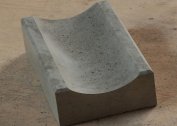A cesspool is an important part of an autonomous sewage system in a private house. Those who live in such a house all year round have to choose an absorbing type cesspool, from which sewage can be pumped out no more than once every six months. The main difference between these tanks from ordinary ones is gradual self-cleaning. To apply any additional cleaning methods in such conditions is much less common. But the topic is no less, after 1-2 years of operation, a serious problem may appear: the water stops leaving. How to solve this problem yourself, you will learn from the article.
Why the water does not go away
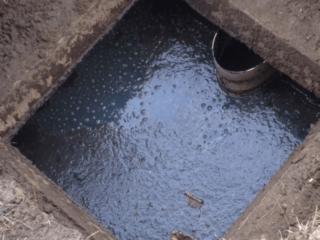 To understand the main causes of the problem, you need to know how the pit is arranged. This is a large tank that is dug right in the ground. Sometimes the bottom of the pit is laid out with small gravel, river sand or broken brick to create a drainage effect. But most often the walls and the bottom are left untouched, that is, they are ordinary soil.
To understand the main causes of the problem, you need to know how the pit is arranged. This is a large tank that is dug right in the ground. Sometimes the bottom of the pit is laid out with small gravel, river sand or broken brick to create a drainage effect. But most often the walls and the bottom are left untouched, that is, they are ordinary soil.
Waste falling into the pit gradually seeps deeper into the ground, but over time, the absorption capacity of the soil decreases, which results in stagnation of water.
The main reasons for the deterioration of soil throughput are as follows:
- Siltation of the bottom. Over time, sludge from feces forms at the bottom. It looks like a cork that retains fluid, and it cannot leak into the ground;
- The formation of fatty deposits on the walls and bottom, which prevents fluid from seeping into the ground;
- If the problem appeared in the winter, then the soil at the bottom of the receiver is frozen and does not allow fluid to pass through;
- Insufficient tank volume. If the size of the pit does not correspond to the amount of waste entering it, this also leads to stagnation of the liquid. Therefore, it is always worth making the size of the tank with a margin, or conduct more thorough preliminary measurements.
Ways to solve the problem
When you find out why the water does not leave the bottom of the receiver, you can choose the right way to deal with this problem.
Sludge disposal
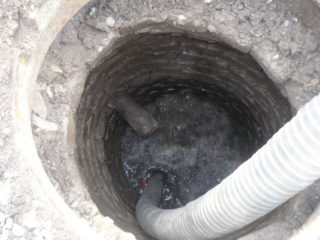 The best way to deal with sludge is special equipment (sludge collector). Such cleaning should be carried out at least once every six months.
The best way to deal with sludge is special equipment (sludge collector). Such cleaning should be carried out at least once every six months.
Sequencing:
- Pump waste from the cesspool;
- Wash the sludge formed on the bottom and walls with a jet of water given under high pressure;
- Clean the bottom and walls with brushes;
- Rinse the tank again and pump out the remaining sludge.
If the sludge could not be cleaned with brushes, you can additionally use these chemicals:
- Formaldehyde products. They are effective, but keep in mind that they have one feature: formaldehyde-based preapartes make the soil unsuitable for any plants for at least 7-10 years. Therefore, try not to use such funds without special need;
- Ammonium based preparations. They also have a small feature: they are effective only at positive temperatures, so they are used only in summer and spring. But they perfectly eliminate unpleasant odors from the cesspool, and dissolve not only sludge, but also greasy deposits on the walls and bottom of the tank;
- Preparations based on nitrate oxidizing agent. This is the best option to deal with poor water outflow. The sludge dissolved by such a preparation can be used to fertilize your vegetable garden and orchard, as it is divided into an organic component and water.
Fat Removal
Grease builds up in the pits faster if the drain not only comes from the toilet and bathroom, but also from the kitchen. The grease left on the dishes, cleaning products which contain surfactants, all this settles not only in the sewer pipes, but also on the walls and bottom of the cesspool.Fat mixes with cold water and becomes a durable layer, preventing the liquid from flowing through the soil.
You can deal with this problem in the same way as with sludge. It is necessary to pump out the waste with the help of special equipment, and only then clean the bottom and walls of the fat layer using brushes, as well as formaldehyde, ammonium and nitrite-based oxidizing agents.
Removing freezing pits in winter
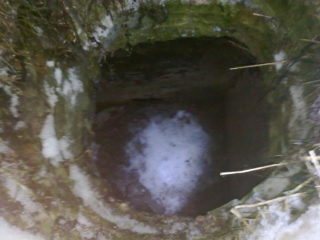 If the bottom of the pit froze during severe frosts, getting rid of this problem will not be easy, but possible. To do this, you will need a long electrical wire with a plug at one end (for inclusion in the network), a metal rod, the length of which should be equal to the depth of the tank, and a lot of hot water.
If the bottom of the pit froze during severe frosts, getting rid of this problem will not be easy, but possible. To do this, you will need a long electrical wire with a plug at one end (for inclusion in the network), a metal rod, the length of which should be equal to the depth of the tank, and a lot of hot water.
Before starting work in the pit, it is important to warm up the remaining elements of communication. Start with the pipeline. Insulate each pipe properly and run the electric cable along its entire length, which will give the maximum warming effect.
When the heating of the pipes is completed, follow this instruction:
- Pump waste from the pit. If they are also cold, warm them with a building hairdryer;
- Now heat one end of a metal rod over a fire, and stick it into a layer of silt, deepening the metal into the ground;
- Wind on the end of the rod sticking out of the ground, the wire stripped from one side, and connect its plug to the network;
- After the sludge has warmed up, remove it with brushes or chemicals.
This method of cleaning the cesspool is quite effective, but note that it may take 12 to 24 hours to warm the sludge.
Solving the problem with insufficient pit volume
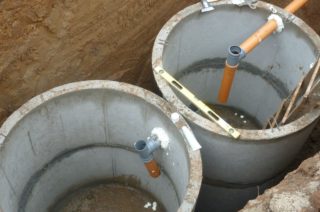 If there are more residents or household appliances (washing machines, dishwashers) in the house, the water consumption becomes greater. Accordingly, the load on the cesspool increases. If the dimensions of the tank can no longer cope with the volume of runoff, you can solve the problem by digging out another tank in the neighborhood.
If there are more residents or household appliances (washing machines, dishwashers) in the house, the water consumption becomes greater. Accordingly, the load on the cesspool increases. If the dimensions of the tank can no longer cope with the volume of runoff, you can solve the problem by digging out another tank in the neighborhood.
Follow this instruction:
- Calculate the required volume for the new tank, and the place where it will be excavated;
- When the new pit is ready, connect it to the first using an overflow pipe;
- Concrete the bottom of the first tank.
The last point can be ignored. But if you lay the bottom of the tank with concrete, you get a cesspool that is safer for the environment. Most of the waste will remain in the first pit, and mainly liquid will fall into the second.
Problem Prevention
You can very well minimize the risk of stagnation of water in the sewer. To do this, observe the following recommendations:
- The most difficult thing is to clean the pit in the winter, so before starting the construction of the cesspool, consider the peculiarities of local soil. Namely, how deep the earth freezes in the cold season. If it freezes hard, you should take care of the insulation of the tank;
- Do not forget that the sewer receiver requires regular pumping of sewage. This should be done at least once every six months, and especially in the case of conservation of sewage for the winter period;
- During each sewage pump, flush the walls and bottom of the receiver with a high-pressure jet of water. This should be done at least once a year, or with each pumping of waste;
- If during pumping out sewage you notice that the bottom and walls of the tank began to become covered with a layer of silt or grease, use chemicals to eliminate them;
- In the intervals between pumping sewage, it is desirable to use preparations based on bacteria. They will speed up the next mechanical cleaning and allow a little delay in the pumping process. In addition, this procedure will help get rid of an unpleasant odor.


